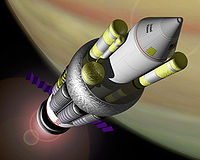
Photo from wikipedia
Hybrid electric propulsion has been identified as a potential solution to the ambitious environmental emissions and noise targets of the aerospace industry. Superconducting machines may be the key component of… Click to show full abstract
Hybrid electric propulsion has been identified as a potential solution to the ambitious environmental emissions and noise targets of the aerospace industry. Superconducting machines may be the key component of that topology enabling the high power densities and efficiencies needed in aerospace. Fully superconducting machines, however, are not a mature technology. This paper looks at the different machine design configurations focusing on the stator magnetic circuit of a fully superconducting motor. The motor has been designed for an aerospace distributed fan propulsion motor with an aerospace benchmark specification of 1 MW. The AC fully superconducting machine includes superconducting bulk magnets mounted on a conventional rotor core and an MgB2 superconducting wire wound stator. The AC losses in the stator winding are particularly sensitive to exposure to the main rotor field so different screening solutions were used to shield the superconducting windings from the rotor field. The effectiveness of the screening techniques for the stator coils and the impact on the machine performance and weight were evaluated for different stator designs, such as full stator core and air core with and without flux diverters. Various combinations of pole numbers, diverter geometries, and magnetic materials have been checked. Results show that there is a tradeoff between stator iron losses and superconducting losses.
Journal Title: IEEE Transactions on Applied Superconductivity
Year Published: 2018
Link to full text (if available)
Share on Social Media: Sign Up to like & get
recommendations!